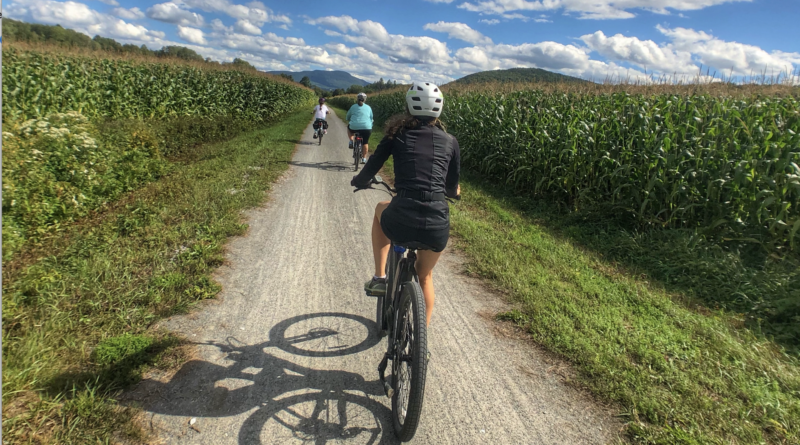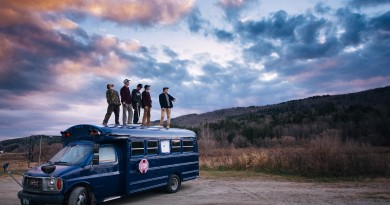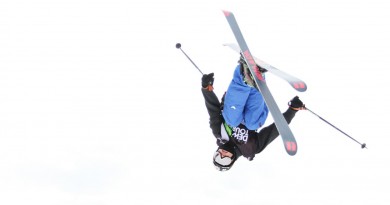Ride Vermont’s Rail Trails
When I was in college, I freight-hopped across the country, experiencing America from the open doors of empty rail cars. Years later, my wife Sue and I took a two-day train journey from Zimbabwe into South Africa. It felt like time was suspended as we crossed the African desert, mesmerized by the rhythmic pulse of rolling steel.
It had been a while since I reveled in a slow ride on a long, flat, straight path through a magnificent landscape. But recently, I have began doing so on two wheels, exploring Vermont’s growing network of rail trails.
In the last few years, miles of rusting steel ribbon that once crossed Vermont have been removed to make way for paths of crushed gravel and cinders, perfect for the rubber soles of running or hiking shoes or two not-so-knobby tires.
Rail routes, once the foundation of travel, still crisscross Vermont’s valleys, carving through farmland and bordering the major rivers, with easy stopovers at brew pubs and wineries, B&Bs, farm stands, classic general stores and old opera houses. Many local bike shops now offer shuttle services, e-bike rentals and trip planning for rail trail riders.
The national rails-to-trails movement dates to the mid-1960s, when the first rail trails opened in the Midwest. In the 1980s, after Congress deregulated the railroad industry, unprofitable routes closed around the country and 4,000 to 8,000 miles of rail lines were abandoned each year. Congress then passed a law to allow for the preservation of abandoned rail corridors and enable their conversion into multi-use trails, a process known as railbanking.
A number of Vermont’s small rail lines closed in the 1980s and 1990s, including the Delaware & Hudson line (now the D&H Rail Trail from Castleton to Rupert), a portion of the Central Vermont Railway (closed in 1985, and now the Missisquoi Valley Rail Trail), and the St. Johnsbury and Lake Champlain Railroad line (closed in 1995, and now the Lamoille Valley Rail Trail). Under Gov. Howard Dean, the state of Vermont moved to railbank the corridors.
Sue Minter, my wife and cycling partner, authored Vermont’s first bicycle and pedestrian plan in 1996, and later served on the House Transportation Committee and was Secretary of Transportation.
She explains:“What we are seeing now is a coming to fruition of efforts begun by Gov. Dean, who championed rail trails throughout the 1990s. The Lamoille Valley Rail Trail got a huge boost in 2005 when then-Rep. Bernie Sanders secured a $5.2 million earmark for VAST to transform an underutilized resource into a bike and snowmobile trail.”
Now, Vermont is on the cusp of a golden age of rail trails. Burlington’s bike path, a feeder to the Island Line Rail trail has been redeveloped and rerouted. The Lamoille Valley Rail Trail is nearly miles complete. It is growing daily with a goal of crossing the entire northern tier of the state, east to west, a total of 93 traffic-free miles by late fall, 2022. By this fall, the last section of the Lamoille Valley Rail Trail should be complete, making it possible to ride from St. Johnsbury to Swanton on the Canadian border. Soon, Vermont will have the longest rail trail in New England, as well as five others that traverse other parts of the state.
While that trail has been spurred on by a recent injection of nearly $14.3 million in state and federal funds, several other rail trails are also being built out.
This past spring, the Cross Vermont Trail saw new sections and a bridge completed in Montpelier, part of a vision that would create a trail that runs from Wells, on the New Hampshire border, to Burlington.
The 19.8-mile Vermont portion of the D&H Rail trail crosses western Rutland and Bennington counties in two sections – one between Castleton and Poultney, the other between West Pawlet and Rupert. When the entire route is completed, you should be able to ride nearly 34 miles from Castleton to West Pawlet, off-road, and then on to New York’s East Salem village.
Two sections of the West River Rail Trail can be ridden now: South Londonderry to Townshend and West Dummerston to Brattleboro. The goal is to open the entire 36-mile route.
Rail trails have several key benefits: there are no cars, they are flat, and they travel through beautiful countryside. They go in a straight line, so you won’t get lost. In winter, many of the trails are used by fat bikes, skiers, and snowmobiles.
I recently rode parts of three Vermont rail trails. All three rail trails are meticulously graded and have surfaces of fine packed gravel (except the paved Burlington Bike Path), making them suitable for all types of bikes. (We used road bikes with standard 700 x 28cm road tires.)
In addition to great riding, we couldn’t pass up another attraction on or near each of these rail trails: Vermont craft breweries. We ended each ride by raising a glass.
While there are dozens of shorter rail trail sections around the state where you can ride, walk, hike or ski, these six trails are worth a day trip or an overnight. Set up camp or check into one of the trailside B&B’s, stop at the local brew pub and make a weekend out of it.
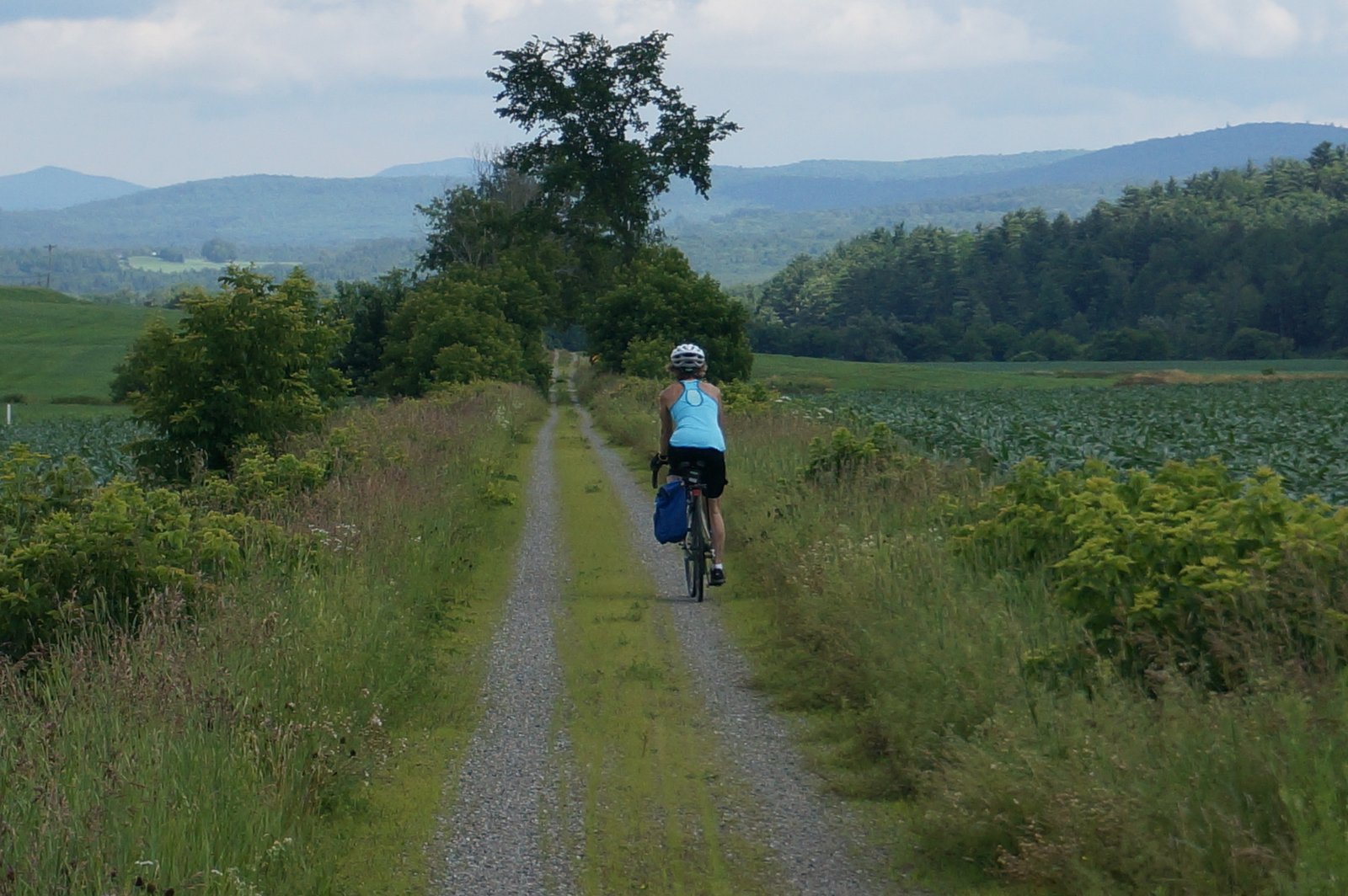
Missisquoi Valley Rail Trail
Length: 26.4 miles,
St. Albans to Richford.
What was once the route of a milk train that serviced the farms of Franklin County is now the Missisquoi Valley Rail Trail (MVRT). In the early 1990s, the State of Vermont and local citizens began converting the former Central Vermont Railway into a multi-use trail that follows the Missisquoi River through the flat farmlands of Franklin County with views east to the Greens.
We started in the Rail City, St. Albans, whose downtown has undergone a renaissance in recent years. The trailhead was easy to find: a large brown MRVT sign and a bicycle mounted high on a post signaled our arrival. A trailhead kiosk and parking lot has free color maps and a guide to the entire trail.
As we rolled out of St. Albans on the well-maintained rail trail, we passed walkers, cyclists and runners in the first few miles. The population on the trail and in the countryside thinned quickly as we rolled through open farmland. Views stretched over miles of green corn fields to where Jay Peak rose in the distance. After 7 miles we came to Sheldon, a former summer resort based around the town’s once famous mineral springs. The 100-room hotels have long since been replaced by dairy sheds that shelter an equivalent number of cows. In 1984, a train derailment damaged a bridge here and that marked the end of the rail service on this line. The Lamoille Valley Rail Trail (see below) connects to the MVRT at mile 9, opening possibilities for extended and even multiday tours across the state. We continued riding through farm fields with views of the northern Greens.
At mile 16 we came to the town of Enosburg Falls, where cyclists can refuel at diners and convenience stores. We stopped to eat lunch in front of the beautifully restored Enosburg Opera House, built in 1892, where a summer theater camp was in full swing and a community theater was rehearsing on stage.
We pedaled on for several more miles north of Enosburg to take in views over the Missisquoi River rapids, which flows parallel the trail. This section of river is part of the Northern Forest Canoe Trail, a water trail that runs from New York to Maine. This scenic high point was where we turned around for a fast ride back to St. Albans. More info: champlainbikeways.org
Nearby Ski Resorts: Smuggler’s Notch, Jay Peak Camp: Lake Carmi State Park is a few miles north of Enosburg Falls. Bike Shops: Bootlegger Bike Shop, Jeffersonville & St. Albans. Fuel Up: The Flying Disc coffee shop in Enosburg Falls not only serves coffee drinks and smoothies and sells jewelry and old vinyl records and canoes you can rent from the town recreation department if you want to leave your bike and paddle back to your car on the Missisquoi.
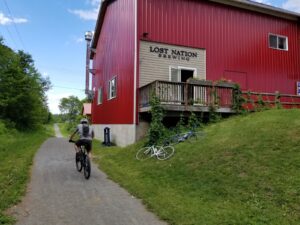
Lamoille Valley Rail Trail
Length: 93 miles
St. Johnsbury to Swanton
After two decades of debate, planning, and construction, the Lamoille Valley Rail Trail is now a reality—partly. Three sections of trail are currently open for riding: St. Johnsbury to Danville (15.4 miles), and Morristown to Cambridge (17.4 miles) and Swanton to Sheldon (11.6 miles). When completed and connected to the Missisquoi Valley Rail Trail, the route will run 93 miles, spanning the state from St. Johnsbury to Swanton. Managed by the Vermont Association of Snow Travelers (VAST), the trail is already popular with snowmobilers and skiers in the winter.
The most popular section, from Morrisville to Cambridge, has been online for several years. We arrived at the trailhead in downtown Morrisville to find a bustling parking lot of riders. Lamoille Valley Bike Tours was there renting electric bikes and one family with small children was happily enjoying the silent electric assist of these bikes.
We headed out on the former St. Johnsbury and Lake Champlain Railroad line, which ceased operation in 1995, and pedaled across a restored railroad bridge. Within a mile, we passed Lost Nation Brewing, a craft brewery and restaurant which is located alongside the trail, and its bike rack was packed. We knew immediately where we would end the day.
The trail follows the meandering Lamoille River in the first few miles. After passing through Hyde Park, we emerged into open farm fields with expansive views of Mt. Mansfield. Sue and I clicked into a rhythm as we rolled through the pastures at a good clip, taking in the different perspective on the mountains that we ski in the winter. As we arrived in Johnson after 8 miles of riding, the skies opened up with rain. We took shelter at a LVRT trailhead kiosk located at a covered picnic spot at Old Mill Park. Several other riders soon joined us.
The sun returned and we rode on to Cambridge, where the old train station has been restored and converted into a community playground with a train theme. We slowly rode through a historic covered bridge and admired the elaborate trusswork.
From Cambridge, a mile-long Greenway Trail brought us to Jeffersonville, where we stopped at The Farm Store, which features an espresso bar, home-baked breads and local products. Sue and I spotted posts outside that were topped with replica golden horse heads.
We both smiled: this was what remained of Le Cheval D’Or, a small French restaurant where I proposed to Sue 32 years ago. Farm Store owner Jennifer Bishop loved hearing our tale, and ran in back to offer us one of the old black lanterns that once hung in the restaurant. Like the railroad, every building has history here. More info: lvrt.org
Nearby Ski Resorts: Smuggler’s Notch, Jay Peak, Stowe. Camp: Mountain View Campground in Morrisville is about 5 miles from the trail. Bike Shops: Bootlegger Bike Shop, Jeffersonville & St. Albans; Lamoille Valley Bike Tours in Johnson, Chuck’s Bike Shop and PowerPlay Sports in Morrisville. Fuel Up: Start or end your ride at Lost Nation Brewery in Morrisville, right on the rail trail.
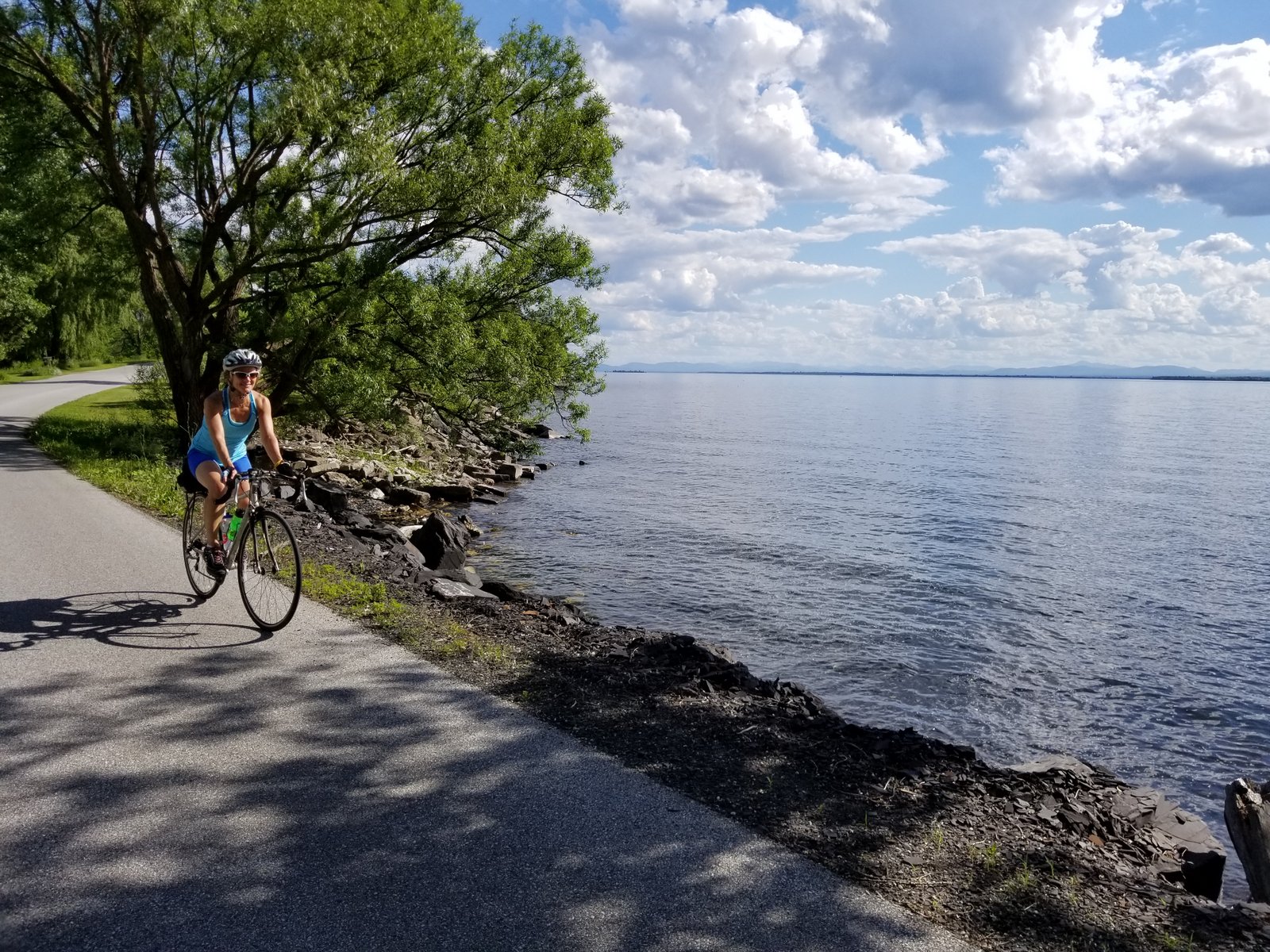
Island Line Trail
Length: 14 miles (rail trail); 30+ miles,
Champlain Islands tour.
One of the most scenic rail trails in Vermont is the Island Line Trail. Started as the Rutland Railroad in 1901, the rail trail runs from Oak Ledge Park in Burlington, follows the shores of Lake Champlain on the Burlington Bike Path, and crosses the lake via a three-mile long causeway to South Hero and a short bike ferry ride. The path is paved until shortly before the causeway, which has a crushed gravel surface.
We set out on a ride through the Champlain Islands by starting at Airport Park in Colchester. After a mile-long ride through the Colchester Bog, the rail trail abruptly launches out into Lake Champlain on a narrow rail bed built atop large marble boulders. We were surrounded by water and mountains. We spun along, with views of the Adirondacks to the west and the Green Mountains to the east. We soon came to The Cut, a 200-foot gap in the causeway, and boarded a bike ferry that Local Motion operates from 10 a.m. to 6 p.m.
Emerging at South Hero, we continued our ride past Snow Farm Vineyard where you can stop for wine tastings from 11 a.m. to 5 p.m. (I suggest you save this for the return leg), often with live bands playing. Sue and continued on the Stone Castles bike tour (so named by champlainbikeways.org, which has a great list of bike tours around Lake Champlain), and had fun finding the many miniature castles that dot the landscape of South Hero. As we cycled by the acclaimed Blue Paddle Bistro in South Hero, we couldn’t resist popping in to make a dinner reservation, then dashed back across the lake to catch the last bike ferry and rode back to the car. More info: localmotion.org
Nearby Ski Resorts: Bolton Valley, Smuggler’s Notch, Jay Peak. Camp: Grand Isle State Park in South Hero or leave your bike in North Hero and kayak out to Knight Island or Woods Island State Parks. Bike Shops: Outdoor Gear Exchange, Burlington; Bootlegger Bike Shop,s St. Albans. Fuel Up: Stop at one of the Champlain Islands winery tasting rooms, such as Snow Farm or Ellison Estate Vineyards or pick up home-made pastries at DonnaSue’s roadside farmstand on Route 2 in Grand Isle.
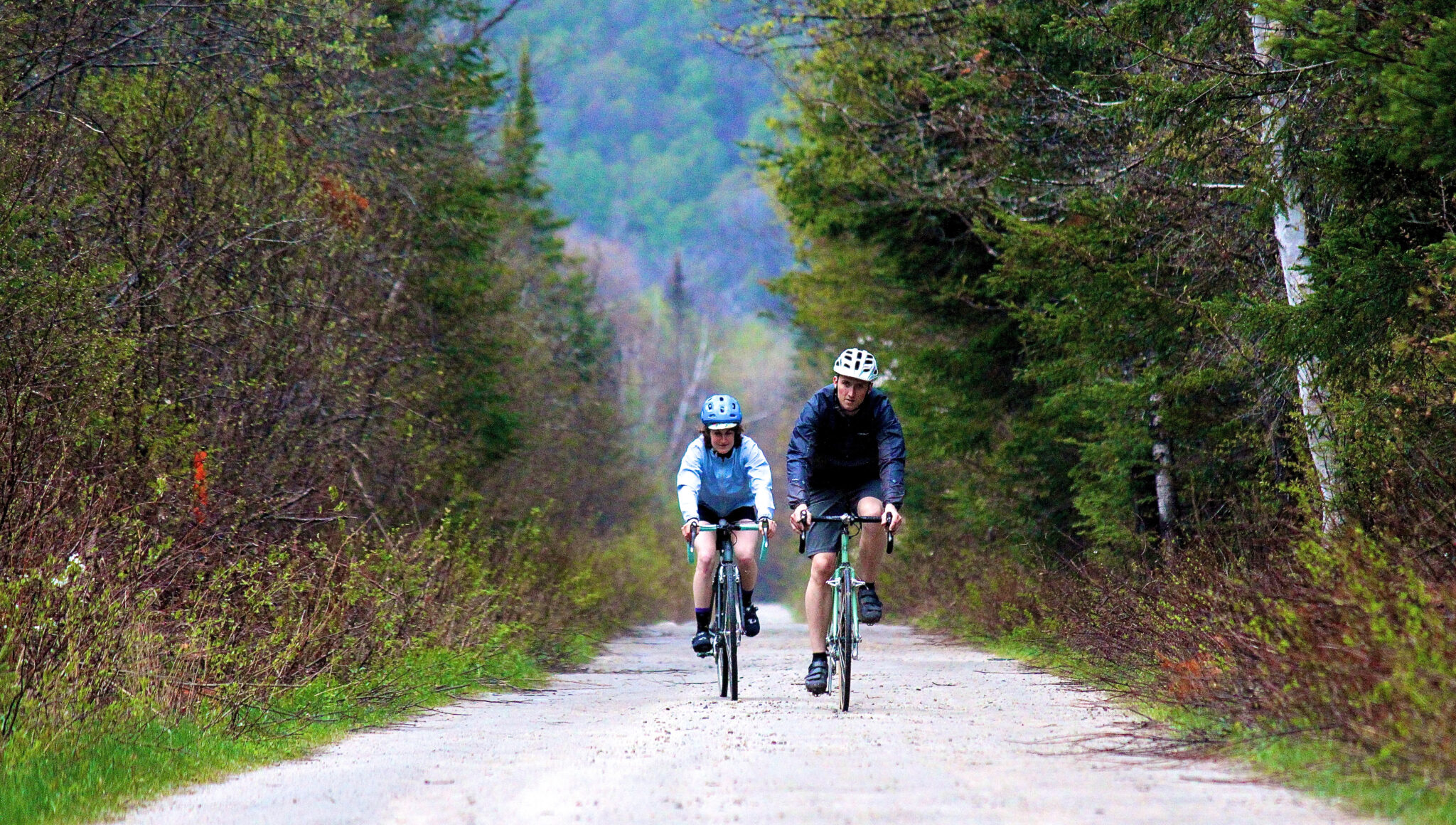
Wells to Montpelier Rail Trail
Length: 18 miles,
South Ryegate to Marshfield
Just south of the Lamoille Valley Rail Trail, the Montpelier-Wells Rail Trail makes up the wildest and most scenic part of a route that’s being mapped and developed as the Cross Vermont Trail, traveling more than 90 mile east/west across the state between Wells and Burlington.
For many years, the “Granite Train” ran a 45-mile stretch of tracks, connecting the mines of Barre with the main train lines that ran down the Connecticut River valley. It’s now made up of three sections, the longest of which runs 18 miles through Groton State Forest.
From Ricker Pond, at the southern end of Groton State Forest, nearly all the way to Marshfield, you can ride dirt and cinder trails through largely undeveloped land. Watch out for moose and deer. Stop at Lake Groton or Kettle Pond for a dip. Camp out at Groton State Park’s many camp sites or book a room at the state-owned Seyon Lodge in the middle of the forest.
In Groton State Forest the trail can get rough at times so be prepared. But you’ll also be rewarded with plenty of places to stop and parking areas where you can cut short the 21-mile ride. More info: crossvermont.org
Nearby Ski Resorts: Sugarbush, Burke, Ascutney. Camp: Groton State Forest has hundreds of great campsites, including several that are lakeside. Bike Shops: Onion River Sports in Montpelier. Fuel Up: Reprovision at the Marshfield General Store or continue on to Positive Pie in Plainfield.
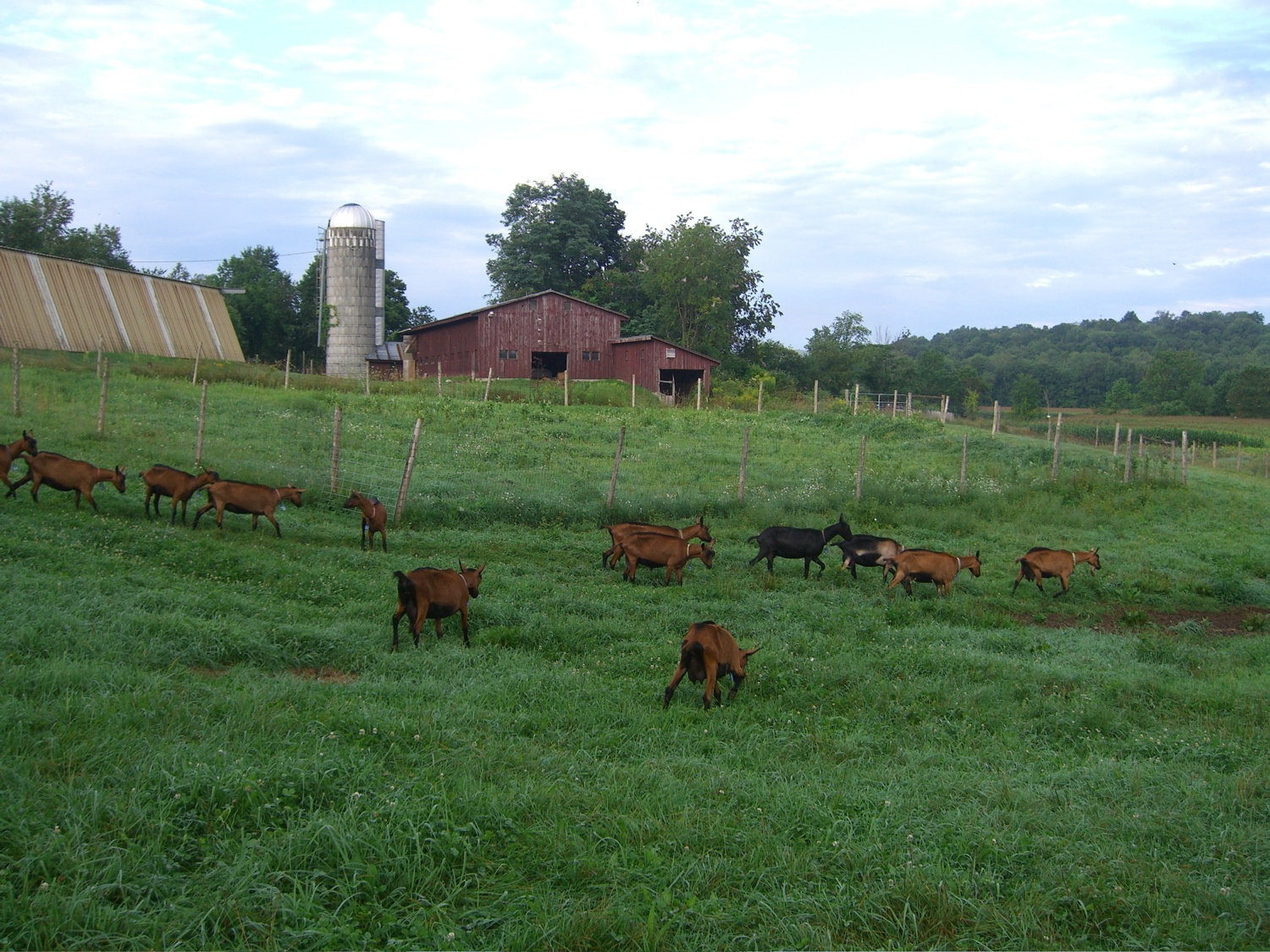
Delaware & Hudson Line Rail Trail
Length:19.8 miles in two sections
Little to no bike or foot traffic, open meadows, a goat farm with a self-serve cheese stand, a slate baron’s mansion (now a B&B) are just a few of the things that make the Delaware & Hudson Line rail trail, one of the most interesting and beautiful trails in the state.
Once named the “The Bridge Line to New England and Canada,” the Delaware and Hudson line once connected New York with Montreal, Quebec and New England. During the 1800s, it transported minerals up and down the East Coast, crossing the western portion of Vermont. “Slate picker” cars stopped in Castleton, Granville and Poultney (a region still known as “slate valley”) and carried roofing slate from Vermont to towns around New England. The railroad went bankrupt in the 1970s and a decade later the state of Vermontpurchased the abandoned tracks and began rehabbing the route as a rail trail and put in more than 17 wood-deck bridges to span the many streams and rivers.
Today, the rail trail still relies on its cinder and gravel bed and is better suited to wider or knobby tires of a hybrid or mountain bike. Start at the Amtrak station in Castleton or at the parking area at the Castleton State College trailhead. From there, the trail runs south to Poultney before crossing into New York. At present, the trail stops for about four miles over the New York border where it becomies densely overgrown, before picking up again in Granville. This is one of two portions that New York State wants to build out and when that is complete, you will be able to ride 34 miles south to West Pawlet and then on to a section New York hopes to rehabilitate, then all the way to East Salem.
If you start or end in Granville, you can make a weekend of it if you book a room at the Station House B&B (in the old train station) or at the red slate Sheldon Mansion Inn whose 10 acres border the trail. A new brewery, Slate Town Brewery is there too.
South of Granville, you’ll ride through some dense forests before it opens up to quiet meadows and farmland. This is one of Rutland Audubon’s birding hotspots, a place where warblers migrate or you might scare up a ruffed grouse. As the trail crosses the 300-acre Consider Bardwell goat farm watch for a small sign for the serve-yourself farmstand with the creamery’s award-winning cheeses and other products. From there you can continue south to West Pawlet.
As one reviewer writes on Traillink.com, “When riding this trail you’re almost always alone with your thoughts – you DO see others but it’s not the highway that other trails can be. It’s a country trail bisecting fields, paralleling a stream for a good portion of the ride, cow pastures, some old ‘urban’ decay near West Pawlet and Granville, but it’s completely scenic, quiet, and easily ridden.” More info: vtstateparks.com/dh-rail-trail
Nearby Ski Resorts: Killington, Pico, Stratton, Bromley. Camp: Lake St. Catherine State Park is a short bike from the trailhead in Poultney or camp or stay in one of the hike-to cabins at the Merck Forest & Farmland Center in Rupert. Bike Shops: Analog Cycles in Poultney or Battenkill Bikes in Manchester. Fuel Up: This area has a wealth of classic Vermont general stores that have been revived and serve farm-fresh fare, including Mach’s Market and Smokehouse in Pawlet, and Sherman’s General Store in Rupert.
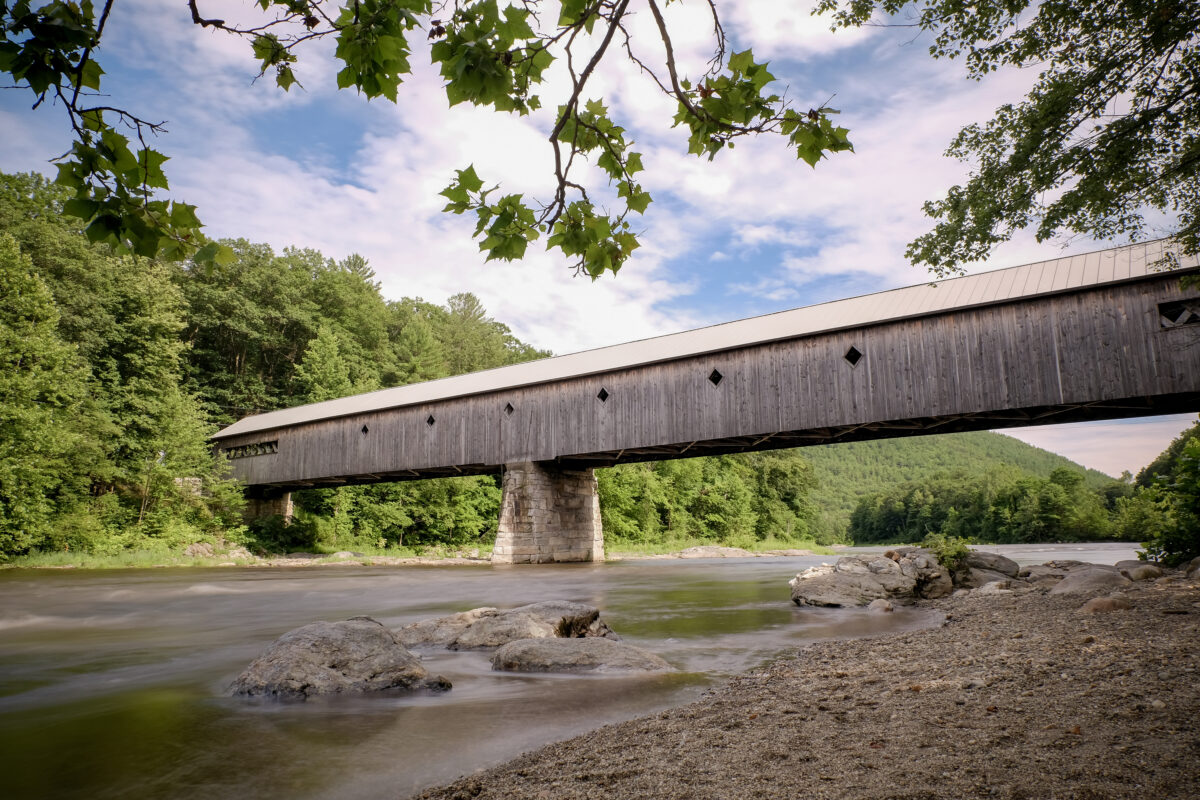
West River Trail, South
Londonderry to Townshend
Length 18.1 miles, Upper Section,
3.5 miles Lower Section
With swimming holes along the way, covered bridges, campgrounds where you can pitch a tent or stay in a shelter, and plenty of places to reprovision, the West River Trail is a great introduction to riding (or walking) a rail trail. The pathway that follows the West River along what may be one of the oldest transportation paths in the state. Native Americans called the West River “the Wantastiquet” or “waters of the lonely way,” and it was part of a system of waterways and overland routes that connected Lake Champlain to the Otter Creek to the West River to the Connecticut in Brattleboro. In 1879, the existing path was developed into a rail bed for the West River Railroad, a winding, narrow-gauge railroad that earned the nickname “36 miles of trouble.” In 1903, a local newspaper dubbed it the “trydaily” route; “they go down in the morning and try to get back at night.”
Today, some of the old depots have been restored and when the trail is completed, it will run the full 36 miles. For now, though, the West River Rail Trail is in two sections – the 18.1 mile upper section from South Londonderry to Townshend and a lower section, from West Dummerston to Brattleboro. The South Londonderry Depot serves as a trailhead and museum for the West River Railroad. Start there and you can follow the trail for about 2.7 miles to the Winhall Brook campground trailhead. From there, it’s about 5 miles south to Ball Lake and Ball Mountain Dam. At Ball Mountain Dam steep switchbacks drop the trail down and it heads on to Jamaica State Park, another 3.5 miles, where you can also camp for the night. At present, the upper section of the West River Trail ends at Townshend Dam, about 18 miles from South Londonderry. A separate 3.5-mile section runs from West Dummerston south to Brattleboro, following the river. More info:
Nearest Ski Resorts: Magic, Bromley and Stratton are all within a 20-minute drive from the South Londonderry trailhead. Camp: Winhall Brook Campground or Jamaica State Park. Bike Shops: Equipe Sports in Rawsonville rents mountain bikes. Fuel Up: Order ahead and pick up takeout house-made sausages and burgers at HoneyPie on Route 30 in Jamaica or provision and pick up pizza or a fajita at West River Provisions in Jamaica. n
Contributing editor David Goodman is the author of Best Backcountry Skiing in the Northeast: 50 Classic Ski and Snowboard Tours in New England and New York. He lives in Waterbury Center, Vt.

